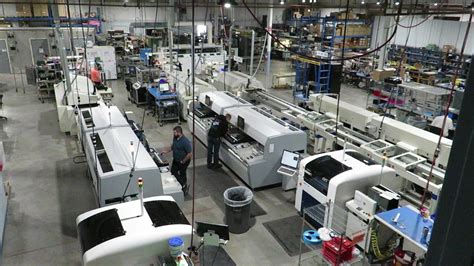Types of SMT Machines
There are several types of SMT machines, each designed to cater to specific manufacturing needs and requirements. The main types of SMT machines include:
1. Pick and Place Machines
Pick and place machines are the most common type of SMT machines. They are used to pick up electronic components from tape reels or trays and place them accurately on the PCB. These machines come in different sizes and configurations, ranging from small benchtop models to large, high-speed production lines.
2. Reflow Ovens
Reflow ovens are used to melt the solder paste and create a permanent bond between the electronic components and the PCB. These machines use a controlled heating process to ensure that the solder melts evenly and forms a reliable connection.
3. Wave Soldering Machines
Wave soldering machines are used for through-hole component assembly. They involve passing the PCB over a molten solder wave, which creates a connection between the component leads and the PCB.
4. Inspection Machines
Inspection machines are used to ensure the quality and accuracy of the assembled PCBs. These machines use various technologies, such as automated optical inspection (AOI) and X-ray inspection, to detect any defects or misalignments in the components or solder joints.
Features of Excellent SMT Machines
When choosing an SMT machine, it is essential to consider the features that make it efficient, reliable, and suitable for your manufacturing needs. Some of the key features of excellent SMT machines include:
1. High Accuracy and Precision
An excellent SMT machine should be capable of placing components with high accuracy and precision. This is particularly important for small components and fine-pitch devices, which require precise placement to ensure proper functionality.
2. Fast Speed and High Throughput
In a competitive manufacturing environment, speed and throughput are crucial factors. An excellent SMT machine should be able to place components quickly and efficiently, minimizing downtime and maximizing production output.
3. Flexibility and Adaptability
An ideal SMT machine should be flexible and adaptable to handle a wide range of component sizes, shapes, and types. It should also be easily configurable to accommodate different PCB designs and production requirements.
4. User-Friendly Interface and Programming
An excellent SMT machine should have a user-friendly interface that allows operators to easily set up, program, and monitor the machine’s performance. It should also have intuitive programming software that enables quick and efficient job changeovers.
5. Robust and Reliable Construction
SMT machines are a significant investment, and they should be built to last. An excellent SMT machine should have a robust and reliable construction, with high-quality components and materials that can withstand the rigors of continuous operation.
Comparison of SMT Machine Types
| Machine Type | Accuracy | Speed | Flexibility | Cost |
|---|---|---|---|---|
| Pick and Place | High | High | High | Medium to High |
| Reflow Oven | N/A | Medium | Medium | Low to Medium |
| Wave Soldering | Low | High | Low | Low to Medium |
| Inspection | High | Medium to High | High | Medium to High |

Frequently Asked Questions (FAQ)
-
Q: What is the difference between SMT and through-hole technology?
A: SMT involves placing components directly onto the surface of the PCB, while through-hole technology involves inserting component leads through holes in the PCB and soldering them on the opposite side. -
Q: How do I choose the right SMT machine for my manufacturing needs?
A: When choosing an SMT machine, consider factors such as your production volume, component types and sizes, PCB complexity, and budget. Consult with SMT machine manufacturers or suppliers to determine the best option for your specific requirements. -
Q: What is the typical lifespan of an SMT machine?
A: The lifespan of an SMT machine depends on various factors, such as the machine’s quality, maintenance, and usage. On average, a well-maintained SMT machine can last between 10 to 15 years or more. -
Q: How often should I perform maintenance on my SMT machine?
A: Regular maintenance is crucial to ensure the optimal performance and longevity of your SMT machine. Follow the manufacturer’s recommended maintenance schedule, which may include daily, weekly, and monthly tasks such as cleaning, calibration, and component replacement. -
Q: Can SMT machines be upgraded to keep up with new technology and requirements?
A: Many SMT machines can be upgraded with new software, hardware, and accessories to enhance their capabilities and keep up with evolving technology and production requirements. Check with your SMT machine manufacturer or supplier for available upgrade options.
In conclusion, SMT machines are essential tools for businesses looking to produce high-quality electronic products efficiently. By understanding the different types of SMT machines and the features that make an excellent machine, you can make an informed decision when selecting the right SMT machine for your manufacturing needs. Investing in a high-quality, flexible, and reliable SMT machine can help you streamline your production process, improve product quality, and stay competitive in the ever-evolving electronics industry.

No responses yet